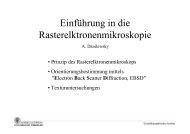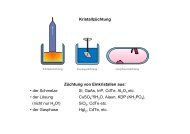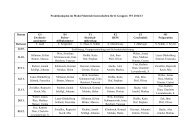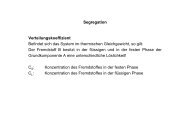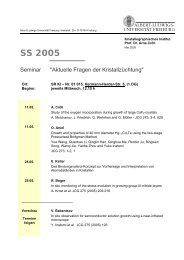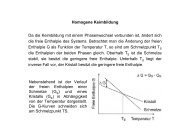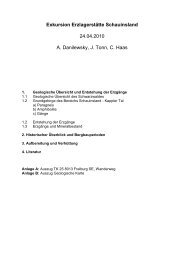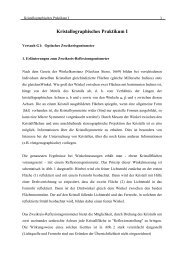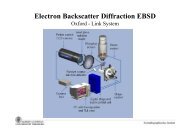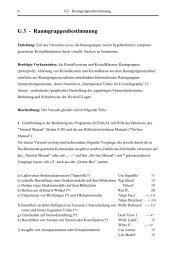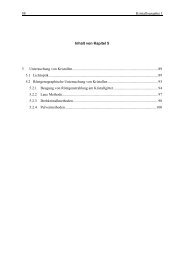(CuSO4 · 5 H2O) from Aqueous Solution
(CuSO4 · 5 H2O) from Aqueous Solution
(CuSO4 · 5 H2O) from Aqueous Solution
Create successful ePaper yourself
Turn your PDF publications into a flip-book with our unique Google optimized e-Paper software.
Experiment Z3:<br />
Growth of Copper (II) Sulphate Pentahydrate<br />
(CuSO 4 · 5 H 2 O) <strong>from</strong> <strong>Aqueous</strong> <strong>Solution</strong><br />
Tutor: Adam Hess<br />
16.10.09<br />
Lab Course “Crystal Growth I” for MSc “Crystalline Materials”<br />
CRYS 412, Crystal Growth Methods I, <strong>Solution</strong> Growth
Contents<br />
1 Overview............................................................................................................... 3<br />
2 Preparations......................................................................................................... 5<br />
2.1 Cleaning................................................................................................................. 5<br />
2.2 Growth Apparatus ................................................................................................. 5<br />
3 Growth of Seed Crystals ..................................................................................... 7<br />
4 Preparation of the Saturated <strong>Solution</strong>............................................................... 8<br />
5 Determination of the Saturation Point of the <strong>Solution</strong> .................................... 9<br />
6 Crystal Growth .................................................................................................. 10<br />
Appendix A: Operating Instructions of the Membrane Pump............................. 11<br />
Appendix B: Solubility Diagram of CuSO 4 · 5 H 2 O in H 2 O .................................. 13
chapter title page<br />
1 Overview 3 of 13<br />
1 Overview<br />
Task:<br />
Crystal growth of CuSO 4 · 5 H 2 O <strong>from</strong> an aqueous solution by means of the temperature<br />
reduction method<br />
Knowledge:<br />
Phase diagrams, nucleation, growth mechanisms (e.g. Kossel crystal), growth morphology,<br />
methods of solution growth, crystal classes, and properties.<br />
Literature:<br />
Handbook Of Crystal Growth, D.T.J. Hurle, North-Holland 1994<br />
Crystal Growth, B.R. Pamplin, Pergamon Press 1975<br />
Kristallzüchtung, K.-Th. Wilke, J. Bohm, Verlag Harri Deutsch, Thun (Frankfurt/Main<br />
1988)<br />
Course duration:<br />
1-2 weeks<br />
Equipment:<br />
Fume hood, growth apparatus with control unit, bright lamp (e.g. cold-light lamp), drying<br />
cabinet with temperature control, various beakers (300 – 2000 ml) with appropriate<br />
cover glasses (watch glasses), crystallizing dish, heating plate with magnetic rotation,<br />
glass rod, thermometer (up to 80 °C), filter paper with matching funnel, laboratory<br />
stand, clamps etc., nylon thread, latex gloves, lint-free paper towels, Teflon tweezers,<br />
plastic tins for storage.<br />
Chemicals:<br />
1000g copper (II) sulphate pentahydrate, several litres of 18 MΩcm H 2 O, detergents,<br />
alcohol (e.g. isopropanol)
chapter title page<br />
1 Overview 4 of 13<br />
Hazards:<br />
Copper (II) sulphate pentahydrate is harmful if swallowed and irritates eyes and skin. It<br />
is also very toxic to aquatic organisms and therefore may not go down the sink. For<br />
your own protection and to avoid contamination of the growth solution always wear<br />
latex gloves. For detailed information see the material safety data sheet .<br />
Finally the growth apparatus has to be labelled, because it can’t be supervised all the<br />
time. The label should contain the following informations:<br />
Experiment title, possible dangers, what to do in emergency case, and contacts of the<br />
responsible persons (Tel.-Nr., …).
chapter title page<br />
2 Preparations 5 of 13<br />
2 Preparations<br />
2.1 Cleaning<br />
Solid particles (dust, lint, etc.) on the devices or in the solution can lead to parasitic nucleation.<br />
These parasite nuclei often occur at advanced stages of the growth process and<br />
destroy the previous work.<br />
Therefore:<br />
‣ Thoroughly clean all equipment parts:<br />
a) Flushing with soap water (you can also use available detergents) and<br />
plenty of tab water<br />
b) Repeatedly rinsing with 18 MΩcm H 2 O (wash bottle)<br />
c) Finally washing down with deionised H 2 O<br />
d) Dripping or drying (drying cabinet)<br />
Warning: Do not heat Plexiglas over 50 °C!!!<br />
‣ Keep receptacles, empty or with solution, always covered (use cover classes of<br />
corresponding size, especially under the fume hood).<br />
2.2 Growth Apparatus<br />
The growth apparatus (see Fig. 1 and Fig. 2) should be prepared as follows:<br />
‣ Fill the outer vessel up to 1-2 cm under the aluminium ring with H 2 O (it may be<br />
possible that it has to be replenished after some days).<br />
‣ Start the pump and set the thermostat (contact thermometer) so that the water<br />
bath gets the chosen temperature.<br />
‣ Thoroughly clean all parts of the crystallizing vessel and the stirring unit (with<br />
detergent) and rinse them several times (first with tab water, then with 18<br />
MΩcm H 2 O). Let the individual parts drain and do not dry it with cloth.<br />
‣ Assemble the equipment immediately, so that no dust <strong>from</strong> the air can get into<br />
the crystallizing vessel.
chapter title page<br />
2 Preparations 6 of 13<br />
Fig. 1 Overview of the growth apparatus for solution growth (here with triglycine sulphate<br />
crystal)<br />
‣ Temperature controller and<br />
circulation pump<br />
‣ Contact thermometer as sensor<br />
for temperature changes<br />
‣ Motor with gearbox for<br />
automatic temperature<br />
regulation<br />
‣ Motor and gearbox of stirring<br />
unit<br />
‣ Outer vessel of the apparatus<br />
‣ Heated solution of the growth<br />
material<br />
‣ Crystallizing vessel<br />
‣ Stirring with seed holder<br />
‣ Heated water bath (18 MΩcm<br />
H 2 O)<br />
Fig. 2 Sketch of the growth apparatus
chapter title page<br />
3 Growth of Seed Crystals 7 of 13<br />
3 Growth of Seed Crystals<br />
While the growth apparatus gets a uniform temperature, a solution for the growth of<br />
seed crystals should be prepared:<br />
‣ Prepare 30 g CuSO 4 · 5 H 2 O with 100 ml 18 MΩcm H 2 O in a 300 ml cooking<br />
cup.<br />
‣ Dissolve the CuSO 4 · 5 H 2 O at about 50 °C under stirring (on heating plate). If a<br />
residue remains one can<br />
a) add 18 MΩcm H 2 O,<br />
b) heat a little more, or<br />
c) filter it out.<br />
‣ Let it stay over night at room temperature (there should be some crystals<br />
formed, see Fig. 3).<br />
‣ Filter the remaining solution over the crystals into a crystallizing dish.<br />
‣ Place six to ten seeds (single-crystals, about 5-10 mm in size) out of the sediment<br />
into a crystallizing dish (set them in approximately equal distances).<br />
‣ Tie a fishing line (about 20 cm in length) to the obtained seeds.<br />
Fig. 3 <strong>Solution</strong> with precipitate and some chosen seed crystals
chapter title page<br />
4 Preparation of the Saturated <strong>Solution</strong> 8 of 13<br />
4 Preparation of the Saturated <strong>Solution</strong><br />
The following steps have to be performed:<br />
‣ Clean up the flask (3 l), suction filter, and funnel, then heat it to about 85 °C in<br />
the drying cabinet.<br />
Attention: Do not heat the sealing cuffs!!!<br />
‣ Choose desired temperature (50-60 °C), at which you want to start your growth.<br />
‣ On the basis of the solubility diagram of CuSO 4 · 5 H 2 O (see Appendix B) calculate<br />
the mass you need to saturate 1000 ml H 2 O at the chosen temperature.<br />
‣ Weigh the calculated mass of CuSO 4 · 5 H 2 O and do it in a cooking cup. Add<br />
1000 ml H 2 O and dissolve at 60 °C on the heating plate with a Teflon stirrer.<br />
During the dissolution (under flue) cover the cooking cup with a watch glass.<br />
‣ Filter the prepared solution into the heated glass equipment (feeding bottle) with<br />
the membrane pump (for operating instructions see Appendix A). Fill the filtered<br />
solution quickly into the crystallizing vessel of the growth apparatus (put<br />
the funnel into the big opening of the Plexiglas cover).<br />
Attention: Do not spill anything! Risk of contamination of the solution by parasitic<br />
seeds!
chapter title page<br />
5 Determination of the Saturation Point of the<br />
<strong>Solution</strong><br />
9 of 13<br />
5 Determination of the Saturation Point of the<br />
<strong>Solution</strong><br />
A seed crystal with cord serves as a “solid-state sensor” for the “streaking method”.<br />
Perform the following steps quickly and with latex gloves to avoid further contamination<br />
of the solution:<br />
‣ Clean seed and cord carefully with alcohol and dip it briefly into deionised H 2 O<br />
to roughen the crystal surface.<br />
‣ Fasten the seed with Teflon tweezers to the Teflon screw of the mixer and close<br />
the crystallizing vessel.<br />
‣ Observe the seed crystal in the back light of a lamp. Three cases are possible<br />
(see Fig. 4):<br />
a) Streaking down Seed crystal dissolves Temperature too high!<br />
b) Streaking up Seed crystal grows Temperature too low!<br />
c) No streaking Saturation Correct temperature!<br />
a) b) c)<br />
Fig. 4 Saturation point determination based on the visual streaks<br />
If the temperature must be corrected, the seed crystal should be removed <strong>from</strong> the solution<br />
and be cleaned every time. Alternatively the saturation point may also be determined<br />
with a seed crystal of lesser quality.
chapter title page<br />
6 Crystal Growth 10 of 13<br />
6 Crystal Growth<br />
‣ If the saturation point has been reached (temperature can vary <strong>from</strong> the chosen<br />
one), adjust the temperature reducer to “1” (Attention: Adjust the switch to<br />
“Temperatur reduzieren”!).<br />
‣ Now observe the growth apparatus for some days and if possible, don’t touch it.<br />
It will probably come to parasitic seed crystal growth, which means further crystals<br />
are being formed in the crystallization vessel. As long as they don’t interfere<br />
with the growth of the crystal at the Nylon cord the growth can be continued.<br />
Otherwise a new (cleaner) saturated solution has to be prepared. Over the whole<br />
time an experiment log has to be written.<br />
‣ After the growth, raise the crystal over the solution and switch off the thermostat.<br />
Do not remove the crystal <strong>from</strong> the crystallization vessel, but let it cool<br />
down over night. On the next day, weigh the crystal and control the mass.<br />
‣ Switch off the thermostat, dispose the remaining solution together with the supervisor,<br />
clean up the growth apparatus, the working place, as well as all equipment<br />
used, and leave all in good condition.
chapter title page<br />
Appendix A: 11 of 13<br />
Appendix A: Operating Instructions of the Membrane<br />
Pump<br />
The blue membrane pump (see Fig. 5) consists of the pump itself and a measurement<br />
system for the pressure.<br />
Fig. 5 Membrane Pump<br />
Turning on the pump and measurement system:<br />
The main switch to turn on the measurement system and the pump is located on the<br />
back of the pump (only the main switch of the pump!).<br />
After pushing the main power switch, the pump is switched on by pushing the second<br />
switch (black) located on the left front side of the pump.<br />
The diaphragm pump offers two ways of evacuation:<br />
1.) Ongoing pumping without regulation (on the display the arrows can`t be seen)<br />
2.) Pumping with the closure of a magnetic valve at a previously defined pressure
chapter title page<br />
Appendix A: 12 of 13<br />
(Attention: The valve closes when the previously set pressure is reached, the<br />
achieved under-pressure in the system is lower!)<br />
On the display ↓↑ is shown.<br />
Set each mode using the button MODE .<br />
Setting the parameters for pumping with magnetic valve:<br />
‣ Setting the lower limit (opening of the magnetic valve) using the buttons Δ ∇ P.<br />
During the programming SET P ↓ appears on the display.<br />
‣ Define the upper limit of the pressure region using the keys Δ ∇ ΔP.<br />
During the programming SET ΔP ↑ appears on the display.<br />
Above the pressure P + ΔP the magnetic valve opens.<br />
Located above the magnetic valve is a manually operated gas valve, which allows a<br />
defined air entrance into the system and to the pump. It is irrelevant whether the magnetic<br />
valve is open or not. This can prevent a too strong pumping at the opening of the<br />
magnetic valve.<br />
After setting the working parameters, the pumping can be started or ended by using the<br />
button START<br />
STOP .<br />
After pumping the system can be aerated using the button VENT .<br />
Display in operation:<br />
↑ Magnetic valve is closed.<br />
↓ Magnetic valve is open, also a symbol of a valve appears.
chapter title page<br />
Appendix B: 13 of 13<br />
Appendix B: Solubility Diagram of CuSO 4 · 5 H 2 O in H 2 O<br />
Solubility of <strong>CuSO4</strong> · 5 <strong>H2O</strong> in <strong>H2O</strong><br />
[kg/l]<br />
2,2 [08.10.2009 16:00 "/Graph1" (2455112)]<br />
Polynomielle Regression für Data1_Solubility:<br />
Y = A + B1*X + B2*X^2 + B3*X^3 + B4*X^4<br />
2,0<br />
1,8<br />
1,6<br />
1,4<br />
1,2<br />
1,0<br />
0,8<br />
0,6<br />
0,4<br />
0,2<br />
0 20 40 60 80 100<br />
Temperature [°C]<br />
Parameter Wert Fehler<br />
------------------------------------------------------------<br />
A 0,2453 0,00129<br />
B1 0,00288 1,90882E-4<br />
B2 1,64041E-4 8,23292E-6<br />
B3 -2,34216E-6 1,30536E-7<br />
B4 2,41153E-8 6,8154E-10<br />
------------------------------------------------------------<br />
R-Square(COD) SD N P<br />
------------------------------------------------------------<br />
0,99997 0,0027 96
Material Safety Data Sheet<br />
Copper sulfate pentahydrate MSDS<br />
Section 1: Chemical Product and Company Identification<br />
Product Name: Copper sulfate pentahydrate<br />
Catalog Codes: SLC3778, SLC4567, SLC3565, SLC5353<br />
CAS#: 7758-99-8<br />
RTECS: GL8900000<br />
TSCA: TSCA 8(b) inventory: No products were found.<br />
CI#: Not applicable.<br />
Synonym: Blue vitriol; Copper (II) Sulfate Pentahydrate<br />
Chemical Name: Cupric sulfate pentrahydrate<br />
Chemical Formula: <strong>CuSO4</strong>.5<strong>H2O</strong><br />
Contact Information:<br />
Sciencelab.com, Inc.<br />
14025 Smith Rd.<br />
Houston, Texas 77396<br />
US Sales: 1-800-901-7247<br />
International Sales: 1-281-441-4400<br />
Order Online: ScienceLab.com<br />
CHEMTREC (24HR Emergency Telephone), call:<br />
1-800-424-9300<br />
International CHEMTREC, call: 1-703-527-3887<br />
For non-emergency assistance, call: 1-281-441-4400<br />
Composition:<br />
Section 2: Composition and Information on Ingredients<br />
Name CAS # % by Weight<br />
Copper sulfate pentahydrate 7758-99-8 100<br />
Toxicological Data on Ingredients: Copper sulfate pentahydrate: ORAL (LD50): Acute: 300 mg/kg [Rat.]. DERMAL (LD50):<br />
Acute: >2000 mg/kg [Rat].<br />
Section 3: Hazards Identification<br />
Potential Acute Health Effects: Hazardous in case of skin contact (irritant), of eye contact (irritant), of ingestion, of inhalation.<br />
Potential Chronic Health Effects:<br />
CARCINOGENIC EFFECTS: Not available.<br />
MUTAGENIC EFFECTS: Mutagenic for mammalian somatic cells.<br />
TERATOGENIC EFFECTS: Not available.<br />
DEVELOPMENTAL TOXICITY: Not available.<br />
The substance may be toxic to kidneys, liver.<br />
Repeated or prolonged exposure to the substance can produce target organs damage.<br />
Eye Contact:<br />
Section 4: First Aid Measures<br />
p. 1
Check for and remove any contact lenses. In case of contact, immediately flush eyes with plenty of water for at<br />
least 15 minutes. Cold water may be used. Get medical attention.<br />
Skin Contact:<br />
In case of contact, immediately flush skin with plenty of water. Cover the irritated skin with an emollient. Remove<br />
contaminated clothing and shoes. Cold water may be used.Wash clothing before reuse. Thoroughly clean shoes<br />
before reuse. Get medical attention.<br />
Serious Skin Contact:<br />
Wash with a disinfectant soap and cover the contaminated skin with an anti-bacterial cream. Seek immediate<br />
medical attention.<br />
Inhalation:<br />
If inhaled, remove to fresh air. If not breathing, give artificial respiration. If breathing is difficult, give oxygen. Get<br />
medical attention.<br />
Serious Inhalation: Not available.<br />
Ingestion:<br />
Do NOT induce vomiting unless directed to do so by medical personnel. Never give anything by mouth to an<br />
unconscious person. If large quantities of this material are swallowed, call a physician immediately. Loosen tight<br />
clothing such as a collar, tie, belt or waistband.<br />
Serious Ingestion: Not available.<br />
Flammability of the Product: Non-flammable.<br />
Auto-Ignition Temperature: Not applicable.<br />
Flash Points: Not applicable.<br />
Flammable Limits: Not applicable.<br />
Products of Combustion: Not available.<br />
Section 5: Fire and Explosion Data<br />
Fire Hazards in Presence of Various Substances: Not applicable.<br />
Explosion Hazards in Presence of Various Substances:<br />
Risks of explosion of the product in presence of mechanical impact: Not available.<br />
Risks of explosion of the product in presence of static discharge: Not available.<br />
Fire Fighting Media and Instructions: Not applicable.<br />
Special Remarks on Fire Hazards:<br />
When heated to decomposition it emits toxic fumes.<br />
<strong>Solution</strong>s are acidic and can react with magnesium to evolve flammable hydrogen gas<br />
Special Remarks on Explosion Hazards: Nitromethanes and copper salts spontaneously form explosive materials<br />
Section 6: Accidental Release Measures<br />
Small Spill:<br />
Use appropriate tools to put the spilled solid in a convenient waste disposal container. Finish cleaning by<br />
spreading water on the contaminated surface and dispose of according to local and regional authority<br />
requirements.<br />
Large Spill:<br />
Use a shovel to put the material into a convenient waste disposal container. Be careful that the product is not<br />
p. 2
present at a concentration level above TLV. Check TLV on the MSDS and with local authorities.<br />
Section 7: Handling and Storage<br />
Precautions:<br />
Do not ingest. Do not breathe dust. Wear suitable protective clothing. In case of insufficient ventilation, wear<br />
suitable respiratory equipment. If ingested, seek medical advice immediately and show the container or the label.<br />
Avoid contact with skin and eyes. Keep away <strong>from</strong> incompatibles such as metals, alkalis.<br />
Storage: Keep container tightly closed. Keep container in a cool, well-ventilated area.<br />
Section 8: Exposure Controls/Personal Protection<br />
Engineering Controls:<br />
Use process enclosures, local exhaust ventilation, or other engineering controls to keep airborne levels below<br />
recommended exposure limits. If user operations generate dust, fume or mist, use ventilation to keep exposure to<br />
airborne contaminants below the exposure limit.<br />
Personal Protection:<br />
Splash goggles. Lab coat. Dust respirator. Be sure to use an approved/certified respirator or equivalent.<br />
Gloves.<br />
Personal Protection in Case of a Large Spill:<br />
Splash goggles. Full suit. Dust respirator. Boots. Gloves. A self contained breathing apparatus should be used<br />
to avoid inhalation of the product. Suggested protective clothing might not be sufficient; consult a specialist<br />
BEFORE handling this product.<br />
Exposure Limits:<br />
TWA: 1 (mg/m3) <strong>from</strong> ACGIH (TLV) [United States] Inhalation<br />
TWA: 0.1 (mg/m3) <strong>from</strong> OSHA (PEL) [United States] Inhalation<br />
TWA: 1 (mg/m3) <strong>from</strong> NIOSH InhalationConsult local authorities for acceptable exposure limits.<br />
Section 9: Physical and Chemical Properties<br />
Physical state and appearance: Solid. (Crystalline granules solid. Powdered solid.)<br />
Odor: Odorless.<br />
Taste: Nauseous metallic.<br />
Molecular Weight: 249.69 g/mole<br />
Color: Blue. (Light.)<br />
pH (1% soln/water): Not available.<br />
Boiling Point: 150°C (302°F)<br />
Melting Point: 110°C (230°F)<br />
Critical Temperature: Not available.<br />
Specific Gravity: 2.28 @ 15.6 deg. C(Water = 1)<br />
Vapor Pressure: Not applicable.<br />
Vapor Density: Not available.<br />
Volatility: Not available.<br />
p. 3
Odor Threshold: Not available.<br />
Water/Oil Dist. Coeff.: Not available.<br />
Ionicity (in Water): Not available.<br />
Dispersion Properties: See solubility in water, methanol.<br />
Solubility:<br />
Easily soluble in hot water.<br />
Soluble in cold water, methanol.<br />
Solubility in water: 31.6 g/100 ml @ 0 deg. C.; 203.3 g/100 ml @ 100 deg. C<br />
Solubility in methanol: 15.6 g/100 ml @ 18 deg. C.<br />
Insoluble in ethanol.<br />
It readily forms alkaline complexes at sufficiently high concentrations of amines or alkali cyanides.<br />
Practically insoluble in most organic solvents.<br />
Stability: The product is stable.<br />
Instability Temperature: Not available.<br />
Section 10: Stability and Reactivity Data<br />
Conditions of Instability: Excess heat (high temperatures), incompatible materials, exposure to air<br />
Incompatibility with various substances: Reactive with metals, alkalis.<br />
Corrosivity: Highly corrosive in presence of steel.<br />
Special Remarks on Reactivity:<br />
Air Sensitive. Slowly efforescent in air. <strong>Solution</strong>s of hyprobromite are decomposed by powerful catalytic action of<br />
cupric ions, even as impurities.<br />
Incompatible with finely powdered metals.<br />
Special Remarks on Corrosivity:<br />
Corrosive to finely powdered metals.<br />
Very corrosive to plain steel<br />
Polymerization: Will not occur.<br />
Routes of Entry: Inhalation. Ingestion.<br />
Toxicity to Animals:<br />
Acute oral toxicity (LD50): 300 mg/kg [Rat.].<br />
Acute dermal toxicity (LD50): >2000 mg/kg [Rat].<br />
Section 11: Toxicological Information<br />
Chronic Effects on Humans:<br />
MUTAGENIC EFFECTS: Mutagenic for mammalian somatic cells.<br />
May cause damage to the following organs: kidneys, liver.<br />
Other Toxic Effects on Humans: Hazardous in case of skin contact (irritant), of ingestion, of inhalation.<br />
Special Remarks on Toxicity to Animals:<br />
Lowest Published Lethal Dose:<br />
LDL [Human] - Route: Oral; Dose: 1088 mg/kg<br />
Special Remarks on Chronic Effects on Humans: May affect genetic material based on animal data<br />
p. 4
Special Remarks on other Toxic Effects on Humans:<br />
Acute Potential Health Effects:<br />
Skin: Causes skin irritation. May cause skin burns. It may cause and itching allergic eczema.<br />
Eyes: Causes eye irritation. May cause eye burns. It may cause conjunctivitis, corneal discoloration, ulceration<br />
and turbidity of the cornea.<br />
Inhalation: Causes respiratory tract (nose, throat, lung) irritation with coughing and wheezing. May cause<br />
ulceration and perforation of the nasal septum if inhaled in excessive quantities. Burning copper sulfate may result<br />
in irritating and poisonous gases which may irritate the respiratory tract and lungs, and may cause fume metal<br />
fever which is characterized by flu-like symptoms such as fever, chills, muscle aches.<br />
Ingestion: Harmful if swallowed. May cause gastrointestinal tract irritation with nausea, vomiting, diarrhea,<br />
metallic taste, burning sensation in the stomach or epigastrum, abdominal pain, and possible gastrointestinal<br />
tract bleeding. May affect metabolism(metabolic acidosis), liver (liver damage, jaundice), blood (Methemoglobin,<br />
hemalytic anemia), urinary system (kidney damage, hematuria, hemoglobinuria, albuminuria), behavior/nervous<br />
systems (somnolence, tremor, psychosis, muscle weakness, coma), cardiovascular system (lowering of blood<br />
pressure, dysthrythmia). Oral mucosa, vomitus, stools, and saliva may be stained blue or green following<br />
ingestion. Aspiration pneumonia may develop following emesis and CNS depression.<br />
Chronic Potential Health Effects:<br />
Skin: Repeated or prolonged skin contact may cause thickening of the skin.<br />
Section 12: Ecological Information<br />
Ecotoxicity:<br />
Ecotoxicity in water (LC50): 0.1 ppm 48 hours [Goldfish]. 0.1 mg/l 96 hours [Rainbow Trout]. 2.5 mg/l 96<br />
hours [Rainbow Trout].<br />
BOD5 and COD: Not available.<br />
Products of Biodegradation:<br />
Possibly hazardous short term degradation products are not likely. However, long term degradation products may<br />
arise.<br />
Toxicity of the Products of Biodegradation: The products of degradation are less toxic than the product itself.<br />
Special Remarks on the Products of Biodegradation:<br />
If released to soil, copper sulfate may leach to groundwater, be partly oxidized, or bind to humic materials, clay, or<br />
hydrous of iron and manganese. In water, it will bind to carbonates as well as humic materials, clay and hydrous<br />
oxides of iron and manganese. Copper is accumulated by plants and animals, but it does not appear to<br />
biomagnify <strong>from</strong> plants to animals. This lack of biomagnification appears common with heavy metals. In air,<br />
copper aerosols (in general) have a residence time of 2 to 10 days in an unpolluted atmosphere and 0.1 to >4 in a<br />
polluted, urban areas.<br />
Section 13: Disposal Considerations<br />
Waste Disposal:<br />
Copper dusts or mist or copper compounds may be disposed of in Group III sealed containers in a secure sanitary landfill.<br />
Copper containing<br />
soluble wastes can be concentrated through the use of ion exchange, reverse osmosis, or evaporators to the point where<br />
copper can be<br />
electrolytically removed and sent to a reclaiming firm. If recovery is not feasible, the copper can be precipitated through the<br />
use of caustics and<br />
the sludge depositied in a chemical waste landfill. Be sure to consult with authorities (waste regulators). Waste must be<br />
disposed of in<br />
accordance with federal, state and local environmental control regulations.<br />
Section 14: Transport Information<br />
DOT Classification: CLASS 9: Miscellaneous hazardous material.<br />
p. 5
Identification: : Environmentally hazardous substance, n.o.s. (Cupric Sulfate) UNNA: 3077 PG: III<br />
Special Provisions for Transport:<br />
additional markings "Marine Pollutant" - required for bulk shipments. The words "Marine Pollutant" must be<br />
entered on the shipping paper in association iwth the basic DOT description for bulk shipments.<br />
Section 15: Other Regulatory Information<br />
Federal and State Regulations:<br />
SARA 313 toxic chemical notification and release reporting: Copper compounds<br />
CERCLA: Hazardous substances.: Copper sulfate pentahydrate: 10 lbs. (4.536 kg)<br />
Other Regulations: OSHA: Hazardous by definition of Hazard Communication Standard (29 CFR 1910.1200).<br />
Other Classifications:<br />
WHMIS (Canada): CLASS D-2B: Material causing other toxic effects (TOXIC).<br />
DSCL (EEC):<br />
R22- Harmful if swallowed.<br />
R36/38- Irritating to eyes and skin.<br />
R50/53- Very toxic to aquatic<br />
organisms, may cause long-term<br />
adverse effects in the aquatic<br />
environment.<br />
S22- Do not breathe dust.<br />
S60- This material and its container must be<br />
disposed of as hazardous waste.<br />
S61- Avoid release to the environment. Refer to<br />
special instructions/Safety data sheets.<br />
HMIS (U.S.A.):<br />
Health Hazard: 2<br />
Fire Hazard: 0<br />
Reactivity: 0<br />
Personal Protection: E<br />
National Fire Protection Association (U.S.A.):<br />
Health: 2<br />
Flammability: 0<br />
Reactivity: 0<br />
Specific hazard:<br />
Protective Equipment:<br />
Gloves.<br />
Lab coat.<br />
Dust respirator. Be sure to use an<br />
approved/certified respirator or<br />
equivalent.<br />
Splash goggles.<br />
p. 6
Section 16: Other Information<br />
References:<br />
-The Sigma-Aldrich Library of Chemical Safety Data, Edition II.<br />
-Hawley, G.G.. The Condensed Chemical Dictionary, 11e ed., New York N.Y., Van Nostrand Reinold, 1987.<br />
Other Special Considerations: Not available.<br />
Created: 10/09/2005 05:01 PM<br />
Last Updated: 10/09/2005 05:01 PM<br />
The information above is believed to be accurate and represents the best information currently available to us. However, we<br />
make no warranty of merchantability or any other warranty, express or implied, with respect to such information, and we<br />
assume no liability resulting <strong>from</strong> its use. Users should make their own investigations to determine the suitability of the<br />
information for their particular purposes. In no event shall ScienceLab.com be liable for any claims, losses, or damages of any<br />
third party or for lost profits or any special, indirect, incidental, consequential or exemplary damages, howsoever arising, even<br />
if ScienceLab.com has been advised of the possibility of such damages.<br />
p. 7



